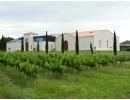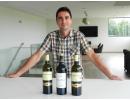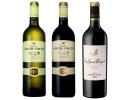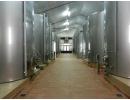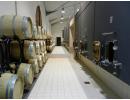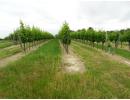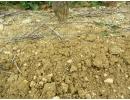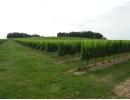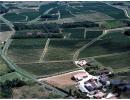Chateau Lamothe Vincent
Château Lamothe-Vincent - Bordeaux Sec
The blend is 85% to 90% Sauvignon Blanc depending on the vintage with the remainder being Semillon. The vines are of an average age of 25 years old planted on clayey-limestone soil producing a yield of 59 hl/ha. Before the vinification the grapes are destemmed and the skins will be macerated for up to 48 hours at a low temperature to extract more colour and flavours. The fermentations will last 2 - 3 weeks depending on the vintage in stainless steel vats. The wine is then aged in stainless steel vats on lees for 2 to 6 months depending on the vintage's potential.
PVins notes: Light yellow in colour, expressive Sauvignon Blanc characteristics with exotic fruits. A dry white, medium-bodied with good freshness and balance. It is a wine to be consumed within 3-4 years.
Château Lamothe-Vincent - Bordeaux
This is the main wine of the Château. The blend is about 80% Merlot depending on the vintage, Cabernet Sauvignon and a little Cabernet Franc since 2016. The vines are of an average age of 25 years old planted on clayey-siliceous limestone soil producing a yield of 50 hl/ha. Before the vinification the grapes are destemmed and the skins will be macerated for up to 6 days at a low temperature to extract tannins for the structure, colour and flavours. The fermentations will last 2 - 3 weeks depending on the vintage in stainless steel vats and 40% - 60% of the volume will have the malolactic fermentations achieved in french oak barrels. The ageing will take about 8 to 10 months in stainless steel vats.
PVins notes: The wine is expressive with black fruit aromas and well integrated and very subtle oak, the palate shows elegant tannins, it is broad, dense, full-bodied with great length. The wine is of excellent value and quality. In excellent vintages the wine may be cellared for up to 8 years.
Château Lamothe-Vincent "Le Grand Rossignol" - Bordeaux Supérieur
Is a new single plot (parcellaire) wine since 2010 made from 100% Merlot. The 2.83 ha plot is located at St-Félix de Foncaude at the lieu dit "Le Moulin de Pourguey" on deep clayey soil and subsoil with an Easterly exposure. The yield averages 42 hl/ha. Before the vinification the grapes are destemmed and the skins will be macerated for 6 days at a low temperature to extract tannins and extra colour and flavours. The fermentations will last 3 to 4 weeks depending on the vintage in concrete vats at 28°C. The ageing will last 16 months in new french oak barrels using 8 different coopers.
PVins notes: The wine is deep black in colour, a complex bouquet of liquorice, blackberries and cedar with hints of toast from the oak. Powerful, rich yet elegant, full-bodied with silky tannins, long finish. In excellent vintages the wine may be cellared for up to 20 years.
Château Lamothe-Vincent is located at Montignac in the heart of the Bordeaux sub-region Entre-Deux-Mers, meaning “between the two seas”. The estate’s history begins in 1873 and 1920 when the great grandparents of Christophe and Fabien VINCENT each bought their first plots. They were unaware that the fruit grown on their land would one day be combined to produce fine wines and that they, too, would be united to form a family of fine wine growers. In 1969 the harvest from the two vineyards were blended to form one estate.
Today, Château Lamothe-Vincent is managed by the 4th generation with Christophe and Fabien. Christophe has been involved with the estate since 1990 with the restructuring of the vineyard. His brother Fabien became involve in the estate in 1999. Fabien's priority was the search for full expression of aromas and balance in the wines. The wines benefit from his constant determination to explore new ways of winemaking and maturing process. Fabien’s wine training experiences in France, New-Zealand and Australia have opened his mind to retain only the best of the Old and New World styles. Today, the estate is ranked by the French wine critics as one of the best wine producer in the category Bordeaux and Bordeaux Superieur appellations. This high standard of quality will be further improved with the new cellar now operational since August 2016.
French version
With the parcels on the communes of Montignac and Castelvieil the estate has a total of 90 hectares, with 80% of it having a southerly exposure. The Merlot, Cabernet Franc and Cabernet Sauvignon represent 75 ha while the Sauvignon Blanc and Semillon make up 14.80 ha. The Merlot variety is the predominant grape grown on the estate. As of 2010 Fabien has decided to produce a premium wine from a single parcel of 2.86 ha located near Castelvieil at St-Félix de Foncaude and situated at the lieu dit "Le Moulin de Pourguey". The soil structure is similar to what you can find in Pomerol and the Merlot vines are planted on a gentle slope providing an ideal natural drainage. Each parcel is treated individually and vinified separately to adapt to its terroir and soil structure as they vary from:
Clayey-siliceous brow going down to a depth ranging from 0 to 10 metres resting on rocky limestone.
Drained silty-clayey soils, with little stones, on a deeper layer of clay enriched with ferrous particles.
Clayey-chalky soils on rocky limestone.
Since the arrival of Christophe in 1990, the vineyard has been restructured. His observation of the vines dates from the age of 12, and his love of the soil shows each day through his endless search for the perfect balance between soils and vines. Christophe and Fabien believe that the natural soil balance is the basis on which to build optimum yields. Management of the vineyards is very important to obtain quality fruit and expression of the terroir. The density of plantation is 4000 vines per hectare, thinning out the leaves on the vines is practiced to minimise the risk of rot by encouraging better ventilation and reducing humidity. This action will also increase sun exposure resulting in riper grapes. Green harvesting is carried out in certain vineyards by removing grape bunches in July to yield riper grapes and to also again reduce the risk of rot. This is however made with moderation to avoid large grapes that might lead to the dilution of polyphenolic compounds weakening the wine. All these steps will enable the grapes to reach full maturity and ripeness to express more positively the character of their particular terroir.
Since September 2013, the estate is HVE Level 3 (High Environmental Value) certified. This label, recognised by the Agricultural Ministry, demonstrates the estate’s efforts to protect at best the environment, based on indicators of results relative to the bio-diversity, the phytosanitary strategy and the management of organic fertilization. Growing grass between the rows of vines has also been implemented to obtain optimal yields, high quality grapes, improve the health and bio-diversity of the vineyard.
To further improve the quality of the wines a new cellar became operational in August 2016 with the latest technology and with a philosophy that “winemaking should never be detrimental to the environment”. Maximum hygiene and minimum manipulation of the wines were the guidelines for its construction as well as the equipment of computer-controlled internal thermoregulation vats. New stainless steel vats and inert epoxy-covered concrete vats were installed for the winemaking and more space was made available for the 250 barrels used for the ageing of some of the wines. Different tank capacities are used varying from 40 to 300 hectolitres in order to respect each individual parcel. Also the winemaking process is done by gravity excluding all pumping action, resulting in a smoother treatment of the fruit.
Both red and white wines express a combination of the Old World (structure) with a touch of the New World (fruit, roundness). Fabien delivers typical structured Bordeaux reds, smooth tannins with some firmness and balance. The reds, full-bodied in style, are a little New World inspired with 14+% alcohol on average, while the whites have expressive aromatics, a touch of New World style. This is obtained naturally with the work and management of the vineyards producing high quality ripe fruit.
For the winemaking process concerning the various Bordeaux reds, the methods are the same for the various cuvées. Firstly the the grapes are sorted and destemmed followed by the pressing of the berries. Pre-fermentation skin maceration for 6 to 8 days at 6°C will be carried out to extract extra colour, flavours and tannins for the strucure of the future wines. Also little micro-oxygenation is practiced resulting in elegant, balanced and aromatically complex wines. The fermentations are done in stainless steel vats or concrete vats depending on the style of the wine for 3 to 4 weeks. Barrels may also be used for the Malolactic fermentations. In the Bordeaux tradition, depending on the wine french oak barrels are used in the ageing process. Fabien has selected 8 coopers, each for their own barrel making method and philisophy which includes the type of oak used and length of the toasting, some coopers are bio-dynamic, all this with the aim of producing complex and elegant wines.
Since the 2010 vintage, Fabien produces a new premium single vineyard wine (selection parcellaire) named "Le Grand Rossignol". It is made with 100% Merlot under the appellation Bordeaux Supérieur, its production is about 6,000 bottles. The wine is fermented in concrete vats and barrel aged for 16 months in new french oak barrels. Due to its structure and complexity the wine has the ability to rival with some Saint Emilion Grand Cru.
The Bordeaux dry whites also benefit from a pre-fermentation skin maceration that will last for about 48 hours at a cold temperature to extract coulour, flavours and texture. The "Bordeaux Sec" will be made in the classic way with the fermentations in stainless steel vats for 2 to 3 weeks, followed by ageing on fine lees for 2 to 6 months depending on the vintage bringing texture and excellent citrusy aromas and flavours. As for the premium white "Heritage" the Semillon and Sauvignon Blanc are fermented seperately in french oak barrels for 2 weeks, then aged for 6 months on fine lees in one year old barrels purchased from a reputable Château in Pessac Leognan.
Links: Entre Deux Mers map - Bordeaux map - www.bordeaux.com



